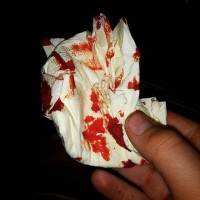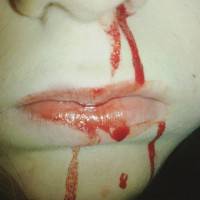Bleeding after rhinoplasty
Bleeding after rhinoplasty
Bleeding after rhinoplasty can occur because of prominent blood vessels and or deflected septum. The one thing that worries me is that you are also having crusting.
I would suggest you get another evaluation and get a biopsy to make sure that you are not having an inflammatory problem and or fungal infections.
While this is probably not the cause it is worth evaluating. (Carlos Wolf, MD, Miami Facial Plastic Surgeon)
I suggest you obtain another consultation from another ENT. The most likely cause is small dilated vessles on your septum.
However, a thorough examination should be performed before a diagnosis of ” a large airway” is given. (Andres Bustillo, MD, FACS, Miami Facial Plastic Surgeon)
Post Rhinoplasty nose bleeds
It is abnormal to have frequent nose bleeds after a rhinoplasty. If you did not have this problem before surgery, then a congenital nose bleeding disorder can be ruled out.
There are some other causes for a nose bleeds, such as excess dryness, retained permanent suture, abnormal cartilage nidus, other foreign body, abnormal musculature, etc.
Make sure you are examined by an experienced and expert nasal surgeon. You might have had excess turbinate resection, might have large septal perforation, etc. There is usually at least some relief possible in these cases with proper diagnosis and treatment. (Boris M. Ackerman, MD, Newport Beach Plastic Surgeon)
Nose Bleeding Following Revision Rhinoplasty
Continued bleeding following prior nose surgery (rhinoplasty, revision rhinoplasty, and even septoplasty) should be evaluated by a nose specialist, particularly if it is this far out from surgery. Simple explanations for something like this include a prominent blood vessel involving the inner lining of the nose (called the mucosa).
The nose is richly supplied with blood, therefore, any bleeding can be quite dramatic. Conservative treatment for this type of issue includes topical ointments, moisturizers, humidification and avoidance of nose blowing.
If this problem persists, it may be addressed with cauterization (either chemically or with an electrical device). Other explanations for persistent nose bleeding after rhinoplasty include chronic scabbing over an exposed suture. In some rhinoplasty surgeries, permanent sutures are placed under the lining to stabilize shape and contour. If the overlying lining becomes too thin, the suture can be exposed.
If this occurs, it is prone to scabbing over continuously. If the scab falls off, bleeding can occur. Despite use of ointments, moisturizers and humidification, this vicious cycle will continue in many cases until the suture is trimmed or cut out.
There is another more severe and worrisome condition, called ozena, whereby the nose can continuously scab and bleed following nose surgery.
This occurs when the surgeon removes too much of the turbinate, which is a natural structure running parallel to the septum inside of the nose.
This is a dreaded complication of turbinate reduction surgery when an over aggressive approach is taken. Hopefully this is not the case with you as it is a very difficult problem to fix. (John M. Hilinski, MD, San Diego Facial Plastic Surgeon)
Bleeding after a rhinoplasty from many years ago has several potential causes including but not limited to: prominent blood vessel deviation of septum – turbulent airflow can cause areas of dryness which can create bleeding septal perforation thinned mucosal lining – dissection in wrong plane can lead to abnormal thinning of septal lining. Dry air- humidification of air and application of nasal lubricant can help allergies or sinus – blood can be found tinged in mucous ozena or atrophic rhinitis- removal of excessive mucosa from the nasal turbinates can lead to dryness and bleeding in the nasal airway nasal trauma- a nice way of saying “nose picking”. The most common cause of nose bleeding overall. after a rhinoplasty, in some cases the mucosa can lead to small portions where crusts can accumulate, which can lead to digital trauma. Hematologic condition – possible but unusual to develop a hematologic condition sponteanously
Bleeding from nose should be evaluated by thorough examination including history and at the very least an anterior rhinoscopy. (Anil R. Shah, MD, Chicago Facial Plastic Surgeon)


